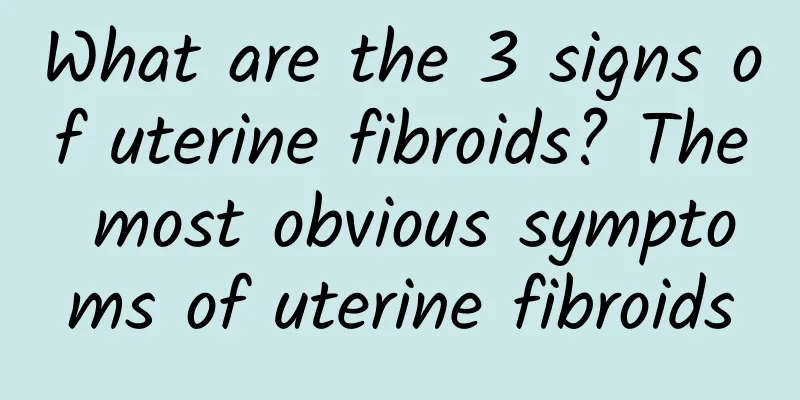What are the 3 signs of uterine fibroids? The most obvious symptoms of uterine fibroids

|
Uterine fibroids are a common gynecological disease that refers to benign tumors that occur in the muscle wall of the uterus. Although most uterine fibroids do not cause obvious symptoms, some women may experience some signs. This article will explore three signs of uterine fibroids and the most obvious symptoms of the disease. 1. What are the three signs of uterine fibroids? 1. Abnormal vaginal bleeding: One of the most common symptoms of uterine fibroids is abnormal vaginal bleeding. Patients may experience bleeding between periods, and their menstrual cycles may also be prolonged. Uterine fibroids may also cause excessive menstrual flow, prolong or intensify menstrual periods, and may even cause anemia. 2. Pelvic pain: Uterine fibroids may also cause pelvic pain. The degree and location of pain vary from woman to woman. Some women may only feel mild discomfort, while others may suffer from severe pain. This pain is usually related to the location and size of the uterine fibroids. 3. Frequent and urgent urination: When uterine fibroids are located at the bottom of the uterus or press on the bladder, patients may experience symptoms of frequent and urgent urination. This is because the pressure of the fibroids on the bladder causes the bladder capacity to decrease, making the patient feel the need to urinate more frequently. 2. The most obvious symptoms of uterine fibroids Although symptoms of uterine fibroids vary from person to person, the most obvious symptom is often abnormal vaginal bleeding. This can be due to the location and size of the fibroid. If the fibroid is located within the uterine cavity or near the cervix, it may interfere with normal menstrual flow and cause irregular bleeding. If the fibroids are large or multiple fibroids are present, they may increase blood flow and cause heavy periods. 3. Popular Science Introduction Uterine fibroids are a common gynecological disease, affecting about 50% of women during their reproductive years. They usually appear in women around the age of 40 and gradually disappear after menopause. The specific cause of uterine fibroids is still unclear, but high estrogen levels, family heredity, and other factors may be related to their development. It is important to note that most uterine fibroids are benign and do not lead to cancer. However, in patients with uterine fibroids, there may also be a rare malignant variant of fibroids, called malignant uterine sarcoma. Therefore, early detection and treatment of uterine fibroids are very important to prevent complications and malignant mutations. Regular gynecological examinations and regular discussions with your doctor about any unusual symptoms are key to the prevention and early treatment of uterine fibroids. The three signs of uterine fibroids include abnormal vaginal bleeding, pelvic pain, and frequent and urgent urination. Of these symptoms, abnormal vaginal bleeding is the most common and obvious. Early detection and treatment are key to preventing complications and malignant mutations. If you have any unusual symptoms, it is recommended to consult a doctor in time to ensure your gynecological health. |
Recommend
Nourish your muscles without gaining fat after exercise! In addition to protein, this is also a tough guy
After exercise, you only build muscle, not fat! P...
Is cervical precancerous lesion cone biopsy expensive?
Faced with cervical cancer, many women feel power...
Why is menstruation irregular?
Why is menstruation irregular? Irregular menstrua...
The recurrence of uterine fibroids is mainly caused by the following reasons
Recurrence of uterine fibroids is a common phenom...
What anti-inflammatory drugs should be taken after painless abortion? How many days should anti-inflammatory injections be taken for painless abortion?
Painless abortion is a safe and effective method ...
How to drain pelvic fluid?
After the onset of pelvic effusion, it is often a...
What is the cure rate for Bartholinitis?
We all know that the occurrence of Bartholinitis ...
Collagen + Astaxanthin helps metabolism for beauty
For girls who are implementing a weight loss plan...
Understand the considerations for menopausal health care
How to do preventive health care during menopause...
What do you need to prepare before an abortion?
Although there are many contraceptive methods to ...
Crazy treasure hunting every day, office ladies get fat! Famous weight loss doctor: for decreased concentration
If you are keen on catching Pokemon, be careful n...
What causes prolonged menstrual bleeding?
What causes prolonged menstrual bleeding? Imprope...
How long after abortion does it take to have a menstrual period?
How long after a miscarriage does it take to have...
What are the dangers of heavy menstrual flow and blood clots?
Heavy menstrual flow with blood clots is an issue...
Reject the fattening New Year’s Eve meals for reunion. Do you know how many calories they contain?
During the New Year reunion, delicacies from land...









